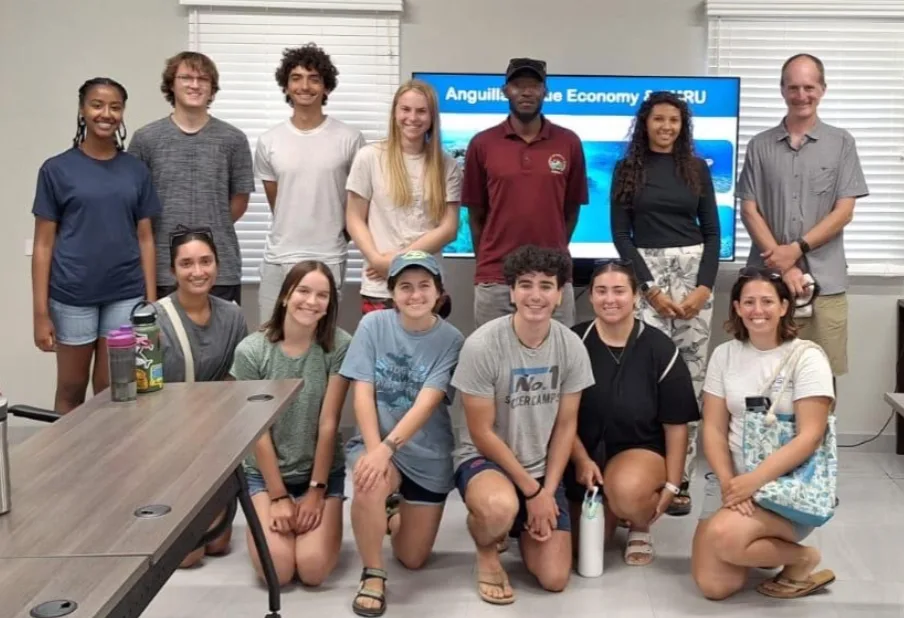Programs Blog
Conservation Ethics in Anguilla

Monday, October 28th, 2024
Location: Crocus Hill, Anguilla
Weather: 80˚ F, rainy and windy
Hi, my name is Sara Abraha, and I’m a junior at Carleton College in MN, majoring in Chemistry with a Biochemistry minor. This semester, I’m incredibly fortunate to be studying coral reefs and conservation in the Caribbean, visiting islands like Anguilla, St. Croix, and Dominica to explore how local communities interact with these vital ecosystems. With each stop, I’m learning firsthand how these environments are shaped by the complex intersections of policy, culture, and science.
While I was in Anguilla, I had some kind of ear infection that kept me from joining my classmates on a visit to the Anguilla National Trust, a central organization for conservation and heritage on the island. Instead, I found myself at the local clinic, experiencing healthcare in a setting that was new to me. Through conversations with my classmates afterward and some personal research on Anguilla’s conservation policies, I gained new insights into the relationship between conservation, local culture, and policy.
The Anguilla National Trust plays a critical role in protecting the island’s resources and its cultural heritage. I found that conservation policies here don’t simply set boundaries to prevent environmental degradation; they also reflect an awareness of how colonial histories and modern economic pressures, such as tourism, shape local perceptions and practices around natural resources.
One major issue is that Anguilla’s conservation goals are often entwined with tourism, an industry that both sustains and strains the island’s resources. Tourism drives economic stability yet places incredible stress on the environment, particularly marine ecosystems. There’s an underlying tension: conservation policies must preserve the natural beauty that attracts visitors, while also ensuring these policies don’t inadvertently exclude locals from the landscapes that have cultural and historical significance to them. This balance becomes especially important given that conservation policies can sometimes privilege certain narratives or landscapes while marginalizing others, often reflecting colonial-era land use practices and values.
What I found compelling was how the Anguilla National Trust’s work challenges this approach, seeking to reframe conservation as something that centers local knowledge and historical continuity. For example, conserving marine parks like Little Bay is about protecting biodiversity, but it’s also about affirming a space that holds communal value; residents can maintain a tangible link to Anguilla’s history and cultural memory. Conservation in this sense becomes an act of reclamation, a way for Anguillans to assert agency over their land and resources in a way that diverges from purely extractive or touristic narratives. It’s a reminder that true conservation considers both the ecological integrity of a space and the social and cultural dynamics that define its value, challenging us to redefine sustainability as a shared responsibility between people, history, and the natural world.
Thanks for reading and until next time!
Recent Posts from the Ships
- Ocean Classroom 2024-A collaborative high school program with Proctor Academy
- Collaborations and Long-term Commitments: SEA’s Caribbean Reef Program Sets a Course for Coastal Programs that Compliment Shipboard Experiences.
- Sea Education Association students prepare for life underway using state of the art nautical simulation from Wartsila Corporation.
- SEA Writer 2022, Magazines From the Summer SEA Quest Students
- Technology@SEA: Upgrades Allow Insight into Ocean Depths
Programs
- Gap Year
- Ocean Exploration
- High School
- Science at SEA
- SEA Expedition
- SEAScape
- Pre-College
- Proctor Ocean Classroom
- Protecting the Phoenix Islands
- SPICE
- Stanford@SEA
- Undergraduate
- Climate and Society
- Climate Change and Coastal Resilience
- Coral Reef Conservation
- Marine Biodiversity and Conservation
- MBL
- Ocean Exploration: Plastics
- Ocean Policy: Marine Protected Areas
- Oceans and Climate
- Pacific Reef Expedition
- The Global Ocean: Hawai'i
- The Global Ocean: New Zealand